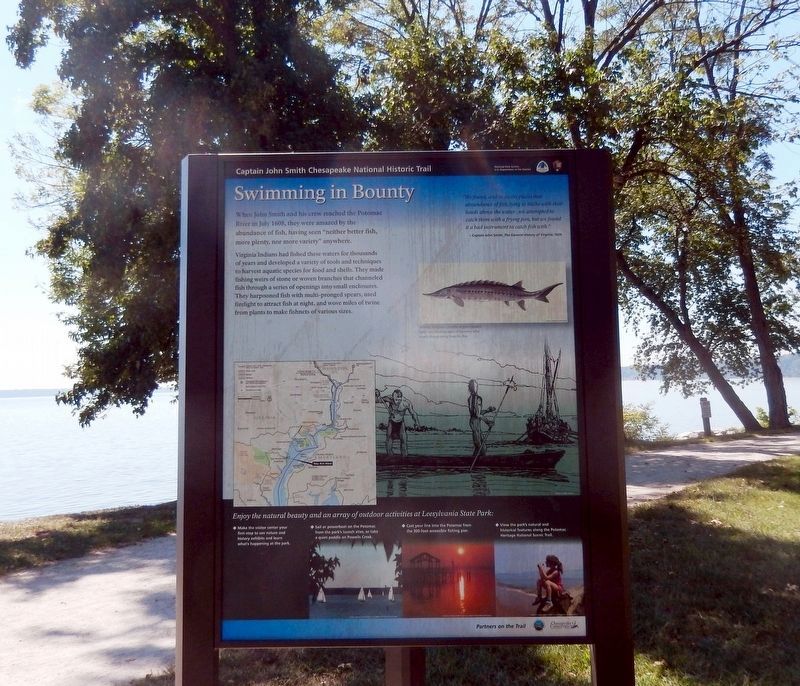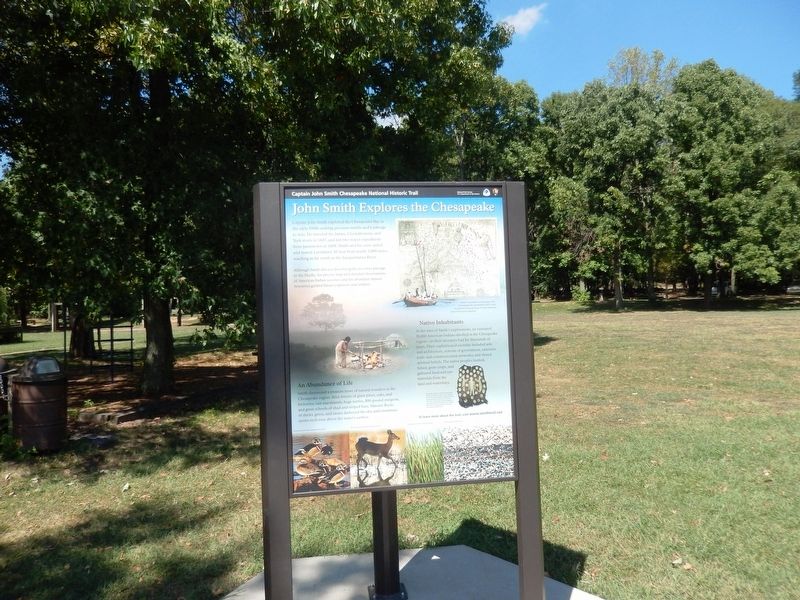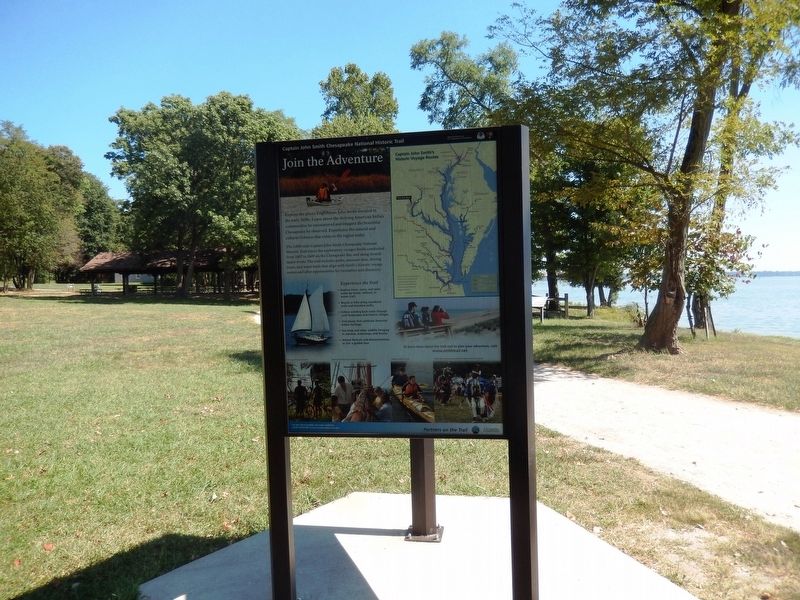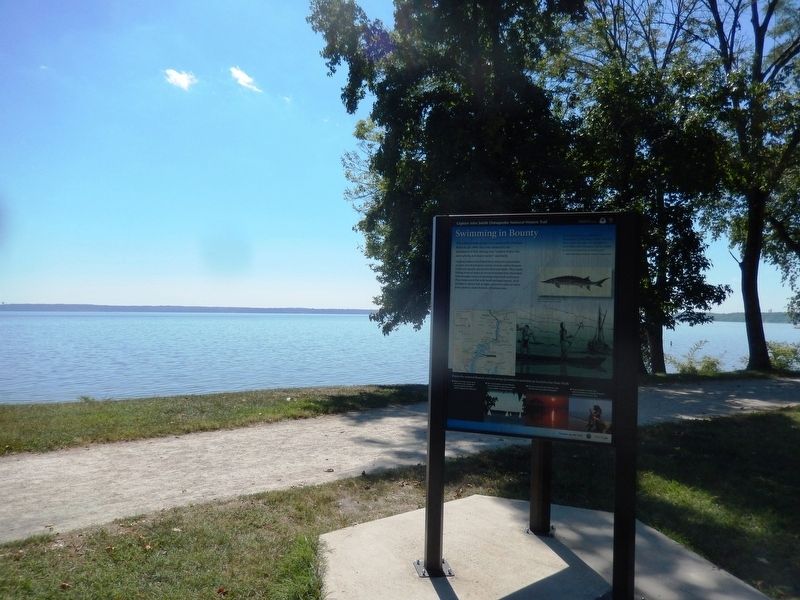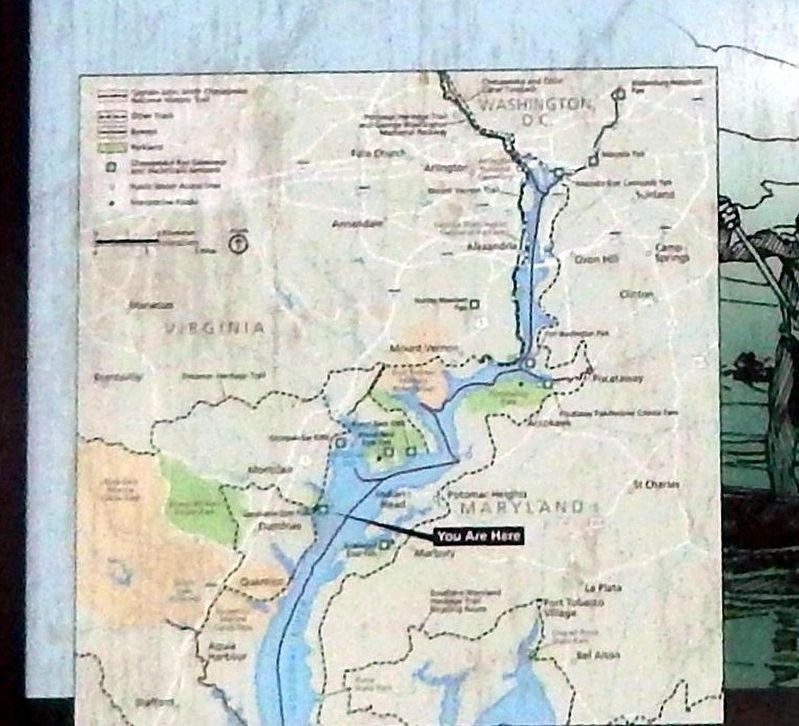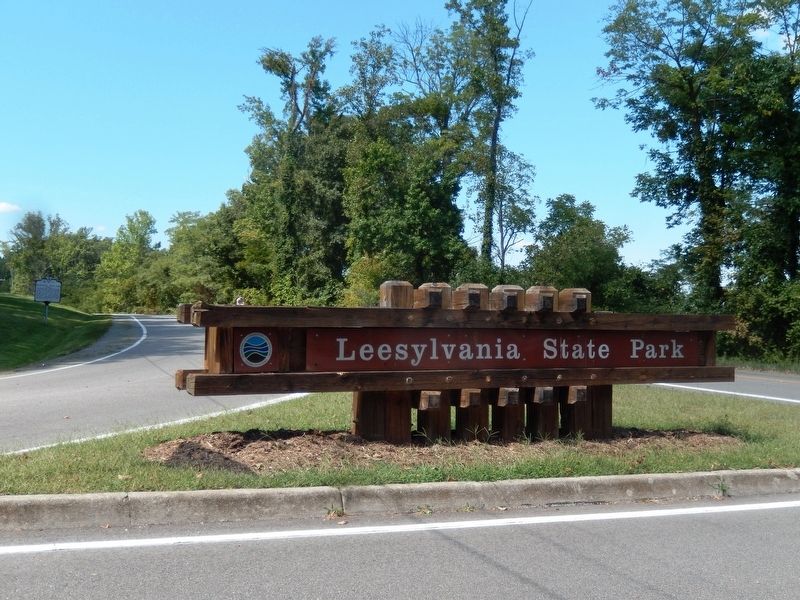Leesylvania in Prince William County, Virginia — The American South (Mid-Atlantic)
Swimming in Bounty
Captain John Smith Chesapeake National Historic Trail
— National Park Service, U.S. Department of the Interior —
(panel 1)
Swimming in Bounty
When John Smith and his crew reached the Potomac River in July 1608, they were amazed by the abundance of fish, having seen “neither better fish, more plenty, nor more variety” anywhere.
Virginia Indians had fished these waters for thousands of years and developed a variety of tool and techniques to harvest aquatic species for food and shells. They made fishing weirs of stone or woven branches that channeled fish through a series of openings into small enclosures. They harpooned fish with multi-pronged spears, used firelight to attract fish at night, and wove miles of twine from plants to make fishnets of various sizes.
“We found, and in divers places that abundance of fish, lying to thicke with their heads above the water...we attempted to catch them with a frying pan, but we found it a bad instrument to catch fish with.”
–Captain John Smith, The General History of Virginia, 1624
(sidebar)
Enjoy the natural beauty and an array of outdoor activities at Leessylvania State Park:
• Make the visitor center your first stop to see nature and history exhibits and learn what’s happening at the park.
• Sail or powerboat on the Potomac from the park’s launch sites, or take a quiet paddle on Powells Creek.
• Cast your line into the Potomac from the 300-foot accessible fishing pier.
• View the park’s natural and historical features along the Potomac Heritage National Scenic Trail.
(panel 2)
John Smith Explores the Chesapeake
Captain John Smith explored the Chesapeake Bay in the early 1600s seeking precious metals and a passage to Asia. He traveled the James, Chickahominy, and York rivers in 1607, and led two major expeditions from Jamestown in 1608. Smith and his crew sailed and rowed a primitive 30-foot boat nearly 3,000 miles, reaching as far north as the Susquehanna River.
Although Smith did not discover gold, or a river to the Pacific, his precise map and detailed observations of American Indian societies and the abundant natural resources guided future explorers and settlers.
Native Inhabitants
At the time of Smith's explorations, an estimated 50,000 American Indians dwelled in the Chesapeake region—as their ancestors had for thousands of years. Their sophisticated societies included arts and architecture, systems of government, extensive trade and communication networks, and shared spiritual beliefs. The native people hunted, fished, grew crops, and gathered food and raw materials from the land and waterways.
An Abundance of Life
Smith discovered a treasure trove of natural wonders
in the Chesapeake region: thick forests of giant pines, oaks, and hickories; vast marshlands, huge turtles, 800-pound sturgeon, and great schools of shad and striped bass. Massive flocks of ducks, geese, and swans darkened the sky; and enormous oyster reefs rose above the water's surface.
To learn more about the trail visit www.smithtrail.net
(captions)
Smith’s remarkably accurate map of the Chesapeake Bay (published in 1612), and his spirited written accounts of a lush landscape inspired European migration.
Decorative shells-such as those found on this ceremonial robe-were valuable in the American Indian’s trading network that extended for hundreds of miles. This robe (which may have belonged to paramount chief Powhatan) was crafted from four elk skins and adorned with more than 17,000 shells.
Wood ducks and other waterfowl flourished
The forests and lowlands teemed with deer
Cattails grew thick in pristine marshes
Flocks of geese filled the sky
(panel 3)
Join the Adventure
Explore the places Englishman John Smith traveled in the early 1600s. Learn about the thriving American Indian communities he encountered and imagine the bountiful Chesapeake he observed. Experience the natural and cultural richness that exists in the region today.
The 3,000-mile Captain John Smith Chesapeake National Historic Trail traces the exploratory voyages Smith conducted from 1607 to 1609 on the Chesapeake Bay and along several major rivers. The trail includes parks, museum sites, driving tours, and water trails that align with Smith's historic voyage routes and offer opportunities for recreation and discovery.
Experience the Trail
• Explore rivers, coves, and open water by kayak, sailboat, or motor craft.
• Bicycle or hike along woodland trails and shoreline paths.
• Follow winding back roads through rural landscapes and historic villages.
• Visit places that celebrate American Indian heritage.
• See birds and other wildlife foraging in marshes, waterways, and forests.
• Attend festivals and demonstrations, or join a guided tour.
To learn more about the trail and to plan your adventure, visit
www.smithtrail.net
(captions)
Captain John Smith’s Historic Voyage Routes
“Here are mountains, hils, plaines, valleys, rivers, and brookes all running most pleasantly into a faire Bay compassed but for the mouth with fruitful and delightsome land.”
– John Smith, 1612
Overlooking the Susquehanna River
Students aboard Discovery at Jamestown Settlement
Kayakers explore the trail
Indian dance demonstration at Jefferson Patterson Park and Monument
Erected by National Park Service, U.S. Department of the Interior.
Topics and series. This historical marker is listed in these topic lists: Colonial Era • Exploration • Native Americans • Settlements & Settlers. In addition, it is included in the Captain John Smith Chesapeake National Historic Trail series list. A significant historical month for this entry is July 1608.
Location. 38° 35.396′ N, 77° 14.967′ W. Marker is in Leesylvania, Virginia, in Prince William County. Marker can be reached from Daniel K Ludwig Drive, 2.3 miles south of Neabsco Road, on the right when traveling east. The marker is located in Leesylvania State Park. Touch for map. Marker is at or near this postal address: 2201 Daniel K Ludwig Drive, Woodbridge VA 22191, United States of America. Touch for directions.
Other nearby markers. At least 8 other markers are within walking distance of this marker. The Freestone Fisheries (within shouting distance of this marker); Iron Pulley Wheel (within shouting distance of this marker); “Pleasureland of the East” (within shouting distance of this marker); "Light Horse Harry" Lee (about 500 feet away, measured in a direct line); Freestone Point Earthworks (about 600 feet away); Lee’s Woods Historic Trail (about 600 feet away); "A Pacific Paradise on the Potomac" (about 600 feet away); The Freestone Point Hunt Club (about 700 feet away). Touch for a list and map of all markers in Leesylvania.
Also see . . .
1. Captain John Smith Chesapeake National Historic Trail. National Park Service (Submitted on September 26, 2016.)
2. Leesylvania State Park. (Submitted on December 2, 2023.)
Credits. This page was last revised on December 2, 2023. It was originally submitted on September 24, 2016, by Don Morfe of Baltimore, Maryland. This page has been viewed 333 times since then and 14 times this year. Last updated on October 3, 2023, by N. Jozsa of Woodbridge, Virginia. Photos: 1, 2, 3, 4, 5, 6. submitted on September 24, 2016, by Don Morfe of Baltimore, Maryland. • Bernard Fisher was the editor who published this page.
